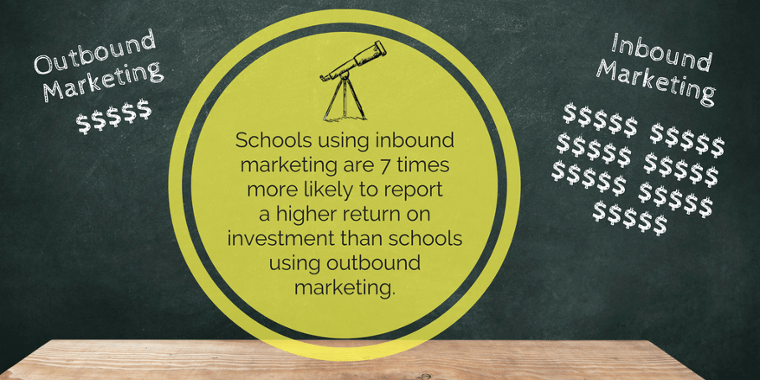Part 2: Using Inbound Marketing to Drive Word-of-Mouth Marketing
In my previous blog, I discussed the reactive nature of marketing shared by many private and independent schools and their need to have a more consistent, proactive marketing strategy.
Word-of-mouth marketing (WOM) is what drives school enrollment. However, unless you’ve cured cancer or baldness, it has the tendency to move the same speed of a glacier. If a school is going to capitalize on WOM and push it a little faster, they must be proactively guiding and participating in the conversation long before it begins. 
Getting Information to the Right People at the Right Time.
Let’s take a look at the beginning stages of a parent who is searching out educational opportunities. It has been found that parents do not begin researching alternatives to education options until they have experienced some type of problem with their current educational institution.
As nice as it would be to have a flow chart to map out the process, there are many factors that will have had an influence on where the parent begins their research. Many parents rely on the opinions and experiences of others when looking at where to begin researching education.
Seeking the opinions of others is normally one of the first steps a parent will make. It may not be the direct question to a friend, “How do you like your school?” It could be the thought, “My neighbor is always saying great things on her Facebook page about her kids and how much they enjoyed their school, I’ll add that to my list of schools to review.”
Where Do I Begin to Start the Marketing Process With My School?
Of course, a parent isn’t going to rely solely on the opinion of a friend or neighbor for such a high consideration decision, and they aren’t quite ready to go to the school for a meeting. Instead, they are going to begin performing extensive amounts of research online. It is here where the parent will begin looking for answers to questions regarding education.
In 2008 a large recession hit a majority of the United States. A private school in the Pittsburgh Pennsylvania area, Sewickley Academy, saw a decline in their inquiries. They tried the traditional methods of marketing but found themselves with little return on investment and a great big hole in their pockets. The director of admissions began doing an extensive amount of research when he came across a book on inbound marketing and experienced his ‘ah-ha’ moment. 
He realized that his school needed to stop talking about Sewickley Academy, and start talking in general about private schools in the Pittsburgh area through online channels. And that is what he did. Sewickley Academy launched an inbound marketing campaign and has continued to see increases in inquiries every year.
Informative Website vs. Inbound Marketing
It has been reported that schools that use inbound marketing are 7 times more likely to report a higher return on investment than schools using outbound marketing, AND inbound leads are three times more qualified than leads acquired through outbound methods.
So, why would a school who has an amazing website, full of relevant information in multiple formats (videos, blogs, ebooks, parent reviews, etc) need to consider inbound marketing?
Inbound marketing helps a school to be found by prospective parents and students. How? When you use the inbound methodology you become familiar with your student and parent personas. You understand their needs, desires, motivations, and questions AND you match those needs, desires, motivations, and questions up with the stages of their decision process (buyer’s journey). This understanding provides you with the ability to address what matters most, when it matters, to your parents and students.
Remember the admissions director from Sewickley? His ‘ah-ha’ moment came when he realized he needed to be talking about his industry- not his school. As he created content that mattered to his personas they were finding Sewickley while performing basic internet searches because the school’s website had the answers to their questions.
Schools who provide information beyond their curriculum or last sporting event get found by possible applicants. Most applicants don’t search “private school with the best curriculum” or “private school who won their football game.” However, when a school answers the needs of their potential applicants, regardless of which stage of the decision process they are in, they will get found.
Visitors are actually more likely to see you as an objective (read: more trustworthy) source if you don’t constantly plug yourself. There are times where your information will be specific to your school, and that is okay. Just make sure there is a balance. Include a mix of general educational topics that are related to, but not specifically about your programs, along with information that is directly tied to your program. Remember, be a resource, not a sales pitch.
Social Media, a School’s Best Friend: Influencing Word of Mouth
Social media provides the perfect opportunity to share information and expertise within your local community on what matters to them. Parents aren’t always experts. They appreciate tips and help in regards to being a parent and educating their child(ren).
Schools have a lot of respect from society when it comes to insight on educating a child. When you are able to share helpful information online and through social media, not only will it be consumed, but it will be shared, liked, retweeted, and talked about in many virtual and social circles.
Use social media and the various platforms to educate your community. Any level of help you can offer a parent or student builds a relationship and an emotional connection. And these are the kinds of relationships people talk about.
Consistency is Key
Schools and education are talked about infinitely day after day, week after week by parents, community members, politicians, grandparents, and neighbors. The ability of a school to actively participate in these conversations has never been as great as it is in today’s society.
If your school is interested in being part of the education conversation and influencing word of mouth you can get started right away with inbound marketing. You don’t have to do everything at once. Take baby steps.
Remember to stay consistent in your school’s marketing efforts. Frequently go back to your buyer persona to make sure you are addressing their needs. As you increase your efforts and your communication, you will find that your school is playing an active part in the conversations within your community.
